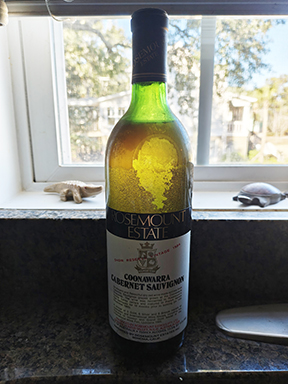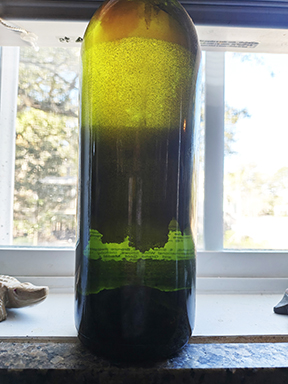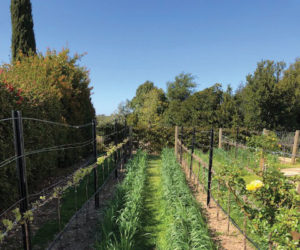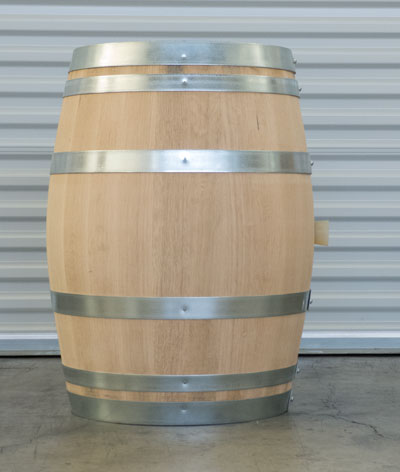Q. I am a former wine shop owner and am going through some bottles in the back of a cabinet at home. I have an Australian Cabernet that is now clear (see photos)! All the color deposited on the bottom of the bottle. It’s from 1984 — I must have gotten it in the ‘90s and then definitely forgot about it. Have you ever seen something like this? what caused the color to deposit? I’m assuming the remaining liquid is bad, but I’m tempted to try it nonetheless. Is that a bad idea? Interestingly, another bottle of the same vintage did not do this.
Martha Andreski
Mt. Pleasant, South Carolina


A. Ah, the joys (and occasional shocks) of rediscovering long-forgotten bottles! Your 1984 Australian Cabernet, now ghostly pale with all its color settled at the bottom, is a fascinating case study in the chemistry of long-term wine aging. You’re absolutely right to assume something unusual has occurred. While I wouldn’t place any bets on its drinkability, your instinct to explore the “why” behind this transformation is a good one. I’m curious myself, so let’s dig in.
Why Did the Color Drop Out?
The color of red wine comes from anthocyanins, the pigments found in grape skins. Over time, these compounds interact with tannins, oxygen, acidity, and the unique microbial world within each bottle, leading to gradual shifts in hue and intensity. Normally, an aged red will transition from deep purple to garnet and eventually to a faded brick or brownish-orange color. In your case, the color hasn’t just faded — it’s completely precipitated out. What caused this extreme loss? Likely a combination of the following factors:
Polymerization and sedimentation: Over time, anthocyanins and tannins bind together into larger molecules, some of which become too heavy to remain in solution. These compounds gradually settle as sediment. In your bottle, this process seems to have gone into overdrive, stripping nearly all the color from the liquid.
Oxidation and chemical breakdown: If the cork allowed tiny amounts of air to seep in, or if large amounts of oxygen was present during bottling, oxygen exposure could have accelerated pigment degradation. Anthocyanins break down over time, especially when oxidation occurs.
Wine pH and tannin-acid balance: Some wines are naturally more prone to pigment instability. A higher pH can make anthocyanins less stable, while an imbalance between tannins and acidity may cause premature precipitation.
Bottle microbiome: Don’t forget that each lot of wine, and eventually each bottle, is its own unique microbiological world. Bacteria and yeast are all around us in the air we breathe and even “sterile-filtered” wine can encounter small amounts of microorganisms on the glass bottle and cork. Though bottled wine is a pretty tough environment for most microbes, some can still slowly grow and metabolize in a low-pH, higher-alcohol environment, creating tiny changes in the wine chemistry over time. Sometimes these tiny changes can create a domino effect, pairing with other factors in this list, to contribute to color loss, change, and precipitation over time.
Storage conditions and bottle variation: Even if both bottles were stored in the same cabinet, tiny differences in temperature, humidity, or cork performance could have influenced how each aged.
Can You Drink It?
Technically, yes. But will it be enjoyable? That’s another matter entirely. If you’re feeling adventurous, follow these steps before taking a sip:
Inspect the wine visually: If it’s clear (aside from sediment), that’s a better sign than murkiness or haze, which could indicate microbial spoilage.
Give it a sniff: Aromas of vinegar, wet cardboard, or nail polish remover mean oxidation or volatile acidity has taken over. If it smells reasonably like aged wine (dried fruit, earth, leather), you might have a chance.
Taste with caution: If it doesn’t immediately make you regret your decision, you may learn something interesting about how wine’s structure holds up (or doesn’t) over decades.
Most likely, this wine has lost its structure, balance, and any remaining fruit character, leaving behind a thin, oxidized shadow of what it once was. But if you do decide to taste it, let curiosity be your guide!
How Does Aging Affect Red Wine Color?
Your bottle presents an extreme case, but red wine’s color evolution over time follows a predictable pattern:
Young reds (1–5 years): Deep purple or ruby hues dominate, thanks to high anthocyanin concentration.
Maturing reds (5–10 years): Vibrant colors soften to garnet as pigments bond with tannins and start settling out.
Aged reds (10–25 years): Brick red hues emerge as anthocyanins degrade further. The wine becomes more translucent, with sediment increasing.
Very old reds (25+ years): The last remnants of pigment may fully precipitate, leaving behind a pale, brownish, or even nearly colorless liquid.
Some factors influence how well a wine holds its color: Acidity (lower pH wines retain color better), tannin structure (more tannins help stabilize pigments), and variety (Cabernet Sauvignon, Nebbiolo, and Bordeaux blends tend to age gracefully, while lighter reds may fade faster).
Why Did One Bottle Keep Its Color?
The fact that another bottle from the same vintage didn’t suffer the same fate is intriguing, but not entirely surprising. Even among wines from the same batch, small variations can lead to vastly different aging outcomes:
Cork integrity: One cork may have provided a better seal, limiting oxidation.
Micro-oxygenation differences: Tiny variations in oxygen exposure at bottling or during storage can influence color stability.
Storage conditions: Slight fluctuations in temperature or humidity, even within the same cabinet, can impact how a wine ages.
Microbial fingerprint: Slightly more natural yeast or bacteria living on a cork or in a bottle can create subtle bottle-to-bottle variations.
Tips for Aging Wine
For best long-term color retention and quality preservation, keep these key storage principles in mind:
Store bottles on their side: This keeps the cork moist and prevents excessive oxygen ingress.
Maintain a consistent, cool temperature: 50–55 °F (10–13 °C) is ideal for slowing chemical reactions.
Minimize light and vibration: UV exposure can accelerate pigment breakdown, and excessive movement can disturb sediment formation.
Choose wines built for aging: Higher-acid, tannic reds with balanced structure tend to best stand the test of time.
Your “ghost Cabernet” is certainly an oddity, but it offers a rare glimpse into wine chemistry in action and is a reminder of how unpredictable and fascinating wine aging can be. If you do take a sip, I’d love to hear your tasting notes — just don’t expect to pour a second glass!
Q. I have been making red wine and bottling with natural cork for a number of years. I recently moved to a place with very little storage for bottling equipment, so I resorted to using smaller swing-top bottles. I keep them in a wine fridge at 55 °F (13 °C). All the seals are in perfect shape and there is no leakage. Any issues with this?
Eddy Beauchamp
via email
A. Your switch from natural cork to swing-top bottles is an entirely reasonable one given your storage constraints, and you’ve taken the right steps to ensure your wine is kept in a stable environment at 55 °F (13 °C). Swing-top bottles with good seals can absolutely work for short- to medium-term storage, provided they maintain an airtight closure. The key difference between traditional cork and swing-tops lies in how they influence the wine’s aging process.

Natural corks allow for a slow, controlled exchange of oxygen over time, which helps red wines develop complexity, soften tannins, and integrate flavors as they mature. Swing-top closures with rubber gaskets tend to create a more airtight seal, limiting that oxygen exchange. This means your wine may age more slowly and retain more of its youthful, fruit-forward character rather than developing the secondary aromas and flavors that a cork-sealed bottle might encourage over years. However, since home winemakers often consume their wine within a few years rather than decades, this may not be a downside at all!
One critical factor in using swing-top bottles successfully is careful selection and ongoing inspection of both the bottles and their seals. Not all swing-top bottles are created equal — some have heavier glass and sturdier wire mechanisms, making them better suited for repeated use. The real weak point, however, is the rubber gasket on the stopper itself. Over time, these gaskets can dry out, crack, or compress, which may compromise the seal and allow unwanted oxygen exposure. If you plan to reuse swing-top bottles over multiple vintages, it’s wise to regularly inspect the gaskets and replace them when they show signs of wear. Some winemakers even swap out standard rubber gaskets for food-grade silicone alternatives, which tend to have greater longevity and resistance to drying out.
Additionally, pay attention to how well the stopper snaps into place. If the wire bail feels loose or the closure doesn’t sit snugly against the bottle rim, you may have an imperfect seal that could lead to oxidation or even leakage over time. While swing-tops offer convenience, they do require some diligence in maintaining their integrity. If you notice inconsistent seals or repeated gasket failures, you might reconsider using them for long-term storage and instead reserve them for wines meant to be enjoyed sooner rather than later.
The real test is how your wine evolves over time in this new format. I’d suggest setting aside a few bottles and tasting them at intervals — six months, a year, two years — just to track how the wine develops. If you like the result and continue to have no issues with leakage or oxidation then you’ve discovered a new way for you to work with your wines. If you feel the need to go back to corks and bottles, that’s fine too. If storage for those things is an issue like it seems to be, you can always share equipment with friends or rent a corker from your local winemaking supply shop (if such a thing exists in your area). Either way you land, you’re adapting to your space while still making and enjoying your own wine, and that’s what truly matters.
Q. When I bottle my wine it is clear. Weeks later the wine has sediment in the bottles. Can you explain the cause? Also, before I bottled the wine tasted perfect, but after a couple weeks it had a funny taste as well. what is going on?
Shawnte Daniel
via email
A. Sounds like you’ve been bottle shocked! That, and you are experiencing some post-bottling sedimentation. You’re not alone in this, my fellow winemaker. Many a vintner, professional and amateur alike, has been surprised to find their once crystal
clear wine throwing some sediment or shifting in flavor after bottling. The good news? You’re not doing anything terribly wrong. The even better news? A little understanding of what’s happening here will help you troubleshoot and refine your winemaking process.
Let’s start with the sediment. You mention that your wine was clear at bottling, but weeks later, little deposits appeared in the bottle. This is completely normal, especially if you didn’t filter your wine before bottling. Even wines that look perfectly clear to the naked eye can still have microscopic particulate matter — proteins, tannins, yeast, and other compounds — that will eventually settle out. This doesn’t mean your wine was improperly handled; it’s simply that given enough time, gravity does what gravity does best, helped along by some normal wine chemistry.
Temperature plays a major role in this process. If bottled in cooler months, your wine likely experienced some temperature up-swings as the weather got warmer, in which case you might be looking at a protein instability. Even slight increases in temperature during aging can cause the naturally present proteins in wines (all of them have some) to coagulate and fall to the bottom of the bottle. Think of when liquid egg whites hit a warm pan — the proteins scramble and become solid, going from clear to opaque white. This can happen, albeit on a smaller scale and in less dramatic fashion, with bottled wines exposed to slight temperature increases and is especially noticeable in white wines.
Time will also have an effect. Tannins and pigments, for example, can bind together over time and fall to the bottom of containers (or to the sides, if stored horizontally), which is why older red wines often develop a fine dusting of color sediment. It’s not abnormal to see some sediment within a few months of bottling, especially if the wine wasn’t fined or filtered. Tartrate crystals, sometimes called “wine diamonds,” can also appear if the wine wasn’t cold stabilized before bottling. These are totally harmless but can give an unexpected crunch to your last sip!
Now, let’s talk about that sudden change in flavor. Before bottling, your wine was likely stored “in bulk” — a carboy, barrel, or tank — where it had a steady, oxygen-limited environment. Bottling, however, changes everything. A small but significant amount of oxygen is introduced, even if you’re careful. This oxygen triggers minor chemical reactions that can alter aromas and flavors, sometimes in ways that are not immediately noticeable. This is why many winemakers give their bottled wines a little time to settle down before passing final judgment on the taste.
But there’s another sneaky culprit at play: Temperature, again! Warmer storage temperatures accelerate chemical reactions in wine, sometimes leading to unexpected shifts in flavor. A wine that tasted balanced in winter may develop off-flavors in the heat of summer if storage conditions aren’t ideal. Higher temperatures can also wake up dormant microbes if there’s any residual sugar or malic acid left in the wine. If your wine wasn’t completely dry or if malolactic fermentation wasn’t fully completed, warmer temperatures might have encouraged a little extra microbial activity in the bottle, leading to subtle (or not-so-subtle) flavor changes.
So, what can you do? If you want to prevent sediment, consider fining and filtering your wine before bottling. A gentle fining with bentonite to reduce the wine’s protein content (reducing the chance of future hazes) or a light filtration can remove many of those pesky particles before they end up in your bottle. Cold stabilizing your wine for a few weeks at near-freezing temperatures can help drop out tartrates before they become an unwelcome surprise.
One of my favorite new cold stability tools is adding a CMC (carboxymethylcellulose), aka cellulose gum, to white wines (don’t use this on reds or rosés as it can cause a haze). When added at the rate of 1 mL/L it can retard the formation of tartrate crystals without having to go through the lengthy process of traditional cold stabilization. CMC is a common food and beverage addition approved by the FDA and TTB and doesn’t change the wine’s taste or aroma. Using it instead of the old-fashioned freeze and filter method actually lowers your wine’s carbon footprint since you won’t be using all that electricity to chill down the wine! Not to mention it’s easier and more affordable for the home micro-vintner. And as always, store your bottled wine in a cool, consistent environment — around 55 °F (13 °C) is ideal — to slow down any unwanted chemical or microbial activity.
I like to give my wines three weeks to get over this bumpy adolescence, aka the “bottle shock” phenomenon. Winemaking is a journey, and every unexpected twist is a chance to learn and refine your craft. Try fining or filtration pre-bottling next time, keep an eye on temperature, give your wines the time they need to settle, and enjoy the ride.







